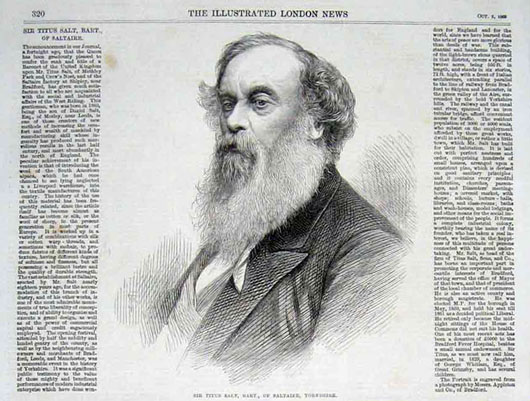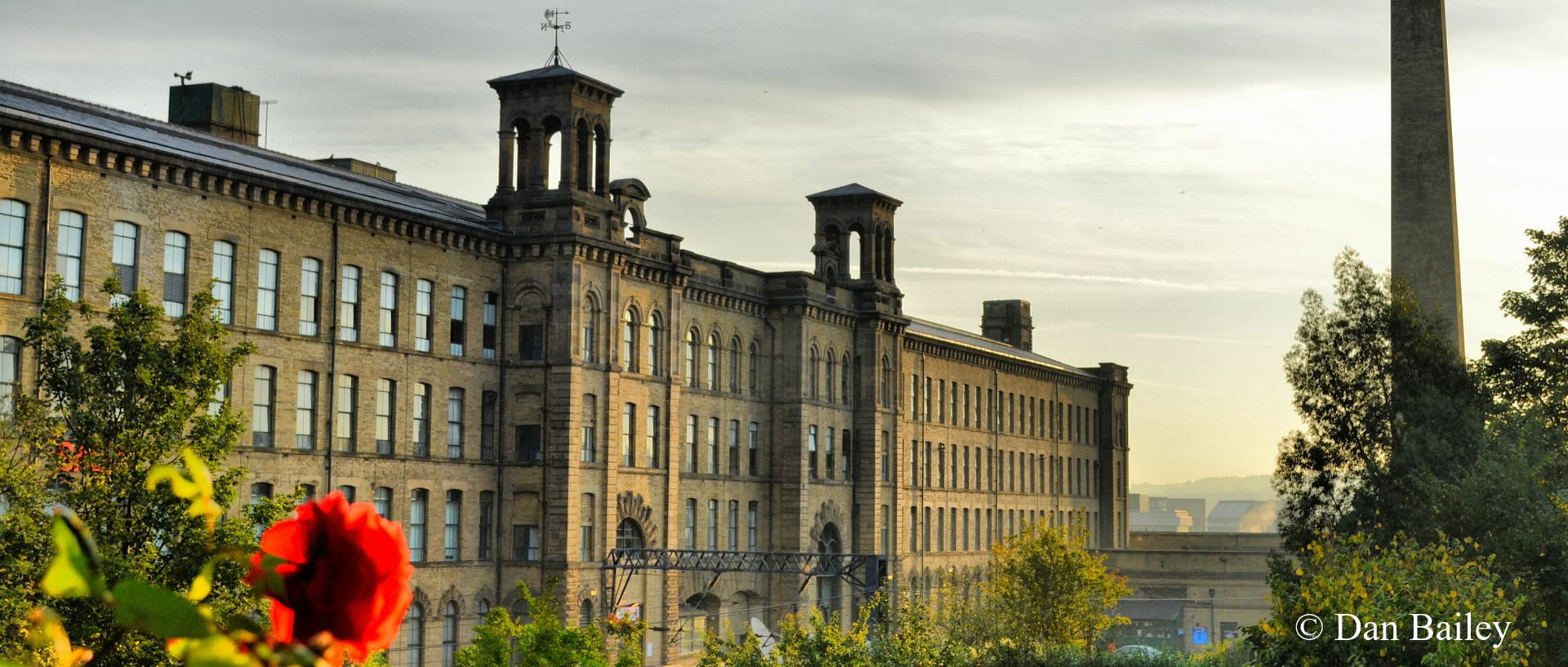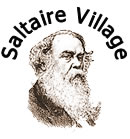These notes are extracted from the Word Heritage Committee Nomination Document, 2001. You can download this comprehensive document from this website.
[You will need Acrobat Reader. If you don't have Acrobat Reader, you can download the software FREE. GET ACROBAT READER - FREE!] GET ACROBAT READER - FREE!]
Photographs and images are additional and are credited.

Titus Salt, featured in the Illustrated London News
After Salt’s death in 1876, only three of his sons took any interest in the business - Titus Junior, who died in 1887 at the age of 44, Edward and George. In July 1881 the firm was registered as a limited liability company under the directorship of Edward and Titus Junior, with Charles and William Stead. Profits went into decline as the mixed fancy goods produced by the company went out of fashion. More important than this was the effectiv eclosing of the American market when President McKinley imposed heavy duties on manufactured products. In a last attempt to secure a corner of the market in America, Salts established a plush fabric plant at Bridgeport USA, but this enterprise failed, and in September 1892 the company was woundup.
Four Bradford businessmen, John Rhodes, John Maddocks, Isaac Smith and James Roberts took over the mill and village in June 1893. The latter became sole owner in 1899 and sold his assets for £2million in February 1918 to another syndicate of Sir James Hill and his sons, Henry Whitehead and Ernest Gates. This company reformed in 1923 to become Salts (Saltaire) Ltd. The village was sold to the Bradford Property Trust in 1933 thus enabling houses to be bought by their occupiers for the first time in the village’s history. During the inter-war period, the new business flourished with raw materials being drawn from all over the globe - South Africa, South America, Australia, India and China. The list of fabrics manufactured at the mill in 1937 i simpressive - mohair, alpaca, cashmere, camel hair, crossbred and botany yarns for both men and women’s clothing, serge or fancy worsted and mohair suiting for men’s wear in great variety, including Belwarp. For women there were serges, gabardines, plain and fancy costume cloth and dress goods, as well as mohair and alpaca linings.
During the Second World War production concentrated on manufacturing goods for the services, employing displaced persons from Eastern Europe. In the 1950s, the ethnic structure of the workforce was to be complemented by male immigrants from Commonwealth countries, employed for the nightshift, which women were not allowed to by law at that time. In 1958 Illingworth Morris & Company Limited purchased the Salt Mill complex for over four and half million pounds. The group also acquired Woolcombers Ltd in 1972, and all the combing activity was moved away from Salts Mill; the dyeing section was closed shortly after, and the spinning eventually contracted out to Daniel Illingworth Limited.
The chimney of the mill stood originally at 76m high, the top 8m were removed in 1971 for safety reasons. In the same year Saltaire was designated a Conservation Area. In the early 1980s, Salts Mill was in economic decline, which affected the village, too. Many of the major buildings became semi-redundant and the fabric of the whole complex began to fall into disrepair. Despite this downturn in fortune, the Saltaire Village Society was formed in 1984 to try and regenerate the area. The mill finally closed in 1986, and was purchased in June of the following year by Jonathan Silver. His dynamic personality was to have a tremendous influence over the whole of Saltaire in the coming years.
- 1987 The 1853 Gallery was opened in the Mill, exhibiting works of the local-born artist with an international following, David Hockney. The world’s media descended on the gallery on 10th November 1989, when Hockney faxed 144 pages of art from California and ‘fax art’ was created.
- 1990 Pace Micro Technology began to rent space in the Mill - a company that is world-renowned for digital technology for satellite, cable and terrestrial receiving equipment.
- 1992 The Royal Mail stamp, designed by Hockney, was launched at the Mill. Major refurbishment programmes started on the shops, the Institute and the School.
- 1993 Instead of being in decline, the Mill had become an exciting, vibrant place, full of activity. Hockney’s ‘very new paintings’ were exhibited (the only place in England to house the paintings), attracting over 90,000 visitors. The Mill has a new Hockney exhibition almost every year. Salt’s Diner opened and it can now accommodate 370 people.
- 1994 Saltaire’s Traders’ Association was formed, with Jonathan Silver as its first president.
- 1996 Prince Charles visited Saltaire to attend a meeting of the ‘Prince’s Regeneration Through Heritage’ scheme, with Salts Mill providing the perfect backdrop for the event. Saltaire won the Civic Trust’s Centre Vision Award.
- 1997 Saltaire won the Europa Nostra award for Conservation-Led Regeneration. This is Europe’s highest award for heritage projects. JonathanSilver died. His ten-year involvement with Saltaire has had an enormous impact on the regeneration and rejuvenation of the Mill and village.
- The Rt. Hon. Chris Smith MP, Secretary of State for Culture, Media and Sport, visited and, more recently, in August 1999, a delegation arrived from the University of Hong Kong’s Department of Geography and Geology. Another stamp based on Hockney’s picture of Salts Mill was produced by thePost Office as part of its millennium celebration.
Saltaire is now a busy, vibrant and economically viable village. The shops on Victoria Road and Gordon Terrace are thriving; domestic property is sought after because of the quality of the environment and the excellent rail links to Leeds and West Yorkshire. The continuing interest in the village’s history and the demand to work and live in today’s Saltaire shows that the original design was part of a successful, sustainable formula.
|


